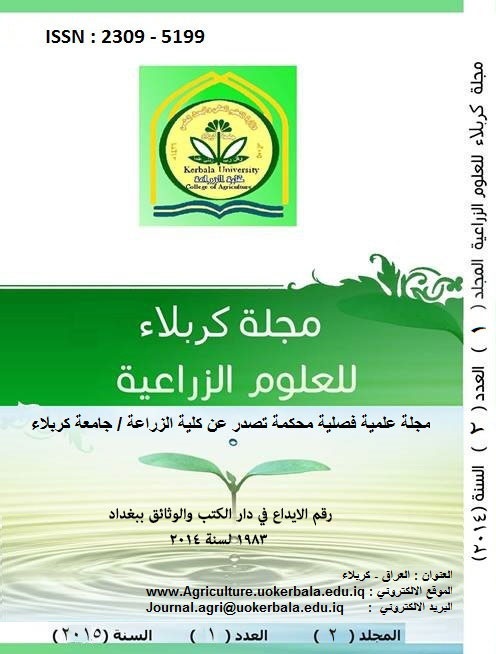Study of the effect of the bacteria "Azotobacter chroococcum" in protection of seeds and seedlings of sunflower (Helianthus annuus L.)
DOI:
https://doi.org/10.59658/jkas.v2i1.454Abstract
This study was conducted during the 2012-2013 growing season, at the College of Agriculture-Kerbala University, to evaluate the efficiency of the chemofungicide "Beltanol" and the biological control bacteria "Azotobacter chroococcum" to control seed decay and seedling damping-off disease caused by Rhizoctonia solani and Fusarium solani in sunflower. Laboratory results showed that the R. solani fungus was more incident than Fusarium solani in the infected sunflower plant samples collected from the agricultural fields. It was noted that R. solani had the most impact in reducing seed germination percentage (%16.70) that was significantly differed from the control treatment.
Results also revealed that the Beltanol chemofungicide applied at a concentration of 1 ml/ 1 L PDA medium was highly effective in inhibiting the fungal growth. A. chroococcum was also efficient in reducing mean radial growth of R. solani that reached 2.40 cm. These results were significantly different from the results obtained from the control treatment containing R. solani alone.
From the plastic house experiment, it was found that treating with A. chroococcum had an effective role in protecting seeds and seedlings from infection with R. solani that led to increase seeds germination to 63.30% and reduce the severity of infection as well as improve the mean of plant length (19.67%). This treatment was significantly different from the control treatment containing R. solani alone that led to an obvious reduction in seed germination percentage, infection severity and plant length that reached 33.30%, 93.00 and 8.67 cm, respectively.
Downloads
Published
How to Cite
Issue
Section
License
Copyright (c) 2015 Copyright (c) 2024 is the Author's article. Published by the Journal of Kerbala for Agricultural Sciences under a CC BY 4.0 license

This work is licensed under a Creative Commons Attribution 4.0 International License.
Licensing Terms
All articles are published under a Creative Commons License and will be directed to the Creative Commons Attribution 4.0 International License (CC BY 4.0) That permits use, distribution, and reproduction in any medium, provided the original work is properly cited. This license also allows the work to be used for commercial purposes.
Use by both non-commercial and commercial users
This content is licensed under a Creative Commons Attribution 4.0 International (CC BY 4.0) license, permitting use by both non-commercial and commercial users. Individual users may access, download, copy, display, and redistribute the articles to colleagues, as well as adapt, translate, and text- and data-mine the content, subject to the following conditions:
- The author's moral rights, including the right of attribution and the right to protect their work from derogatory treatment, are respected.
- Where content in the article is identified as belonging to a third party, users must ensure that any reuse complies with the copyright policies of the owner of that content.
- If the article content is reused for research or educational purposes, users should maintain a link to the appropriate bibliographic citation, including the DOI and a link to the published version on the journal's website.

